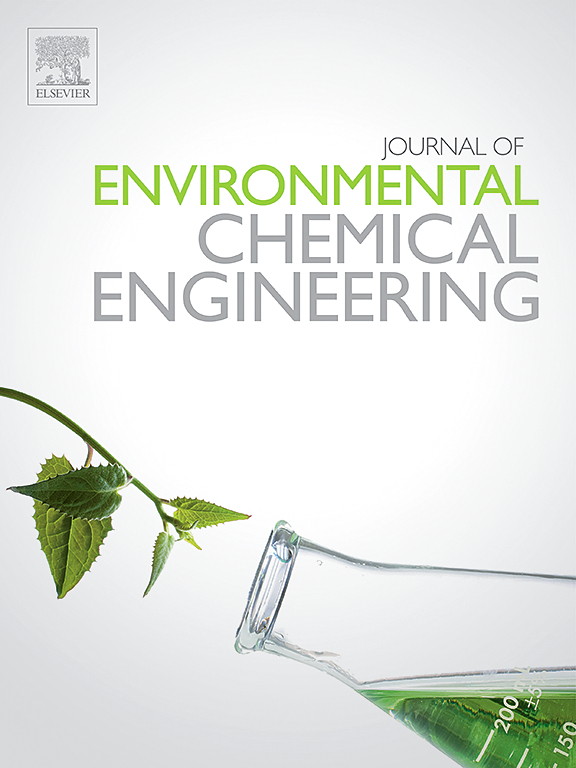微藻在二氧化碳捕获、废水处理和生物柴油生产中的协同作用研究进展
IF 7.4
2区 工程技术
Q1 ENGINEERING, CHEMICAL
引用次数: 0
摘要
这篇综述探讨了微藻作为二氧化碳减排和废水处理的可持续解决方案,特别是在资源有限的海湾合作委员会地区。该研究强调了微藻生物柴油生产的最新进展,并推广了将二氧化碳捕获、养分回收和生物燃料生产相结合的综合系统,以支持循环生物炼制模式。微藻,特别是小球藻具有很高的光合效率,其CO₂固定率高达1.5 g CO₂/L/d,同时从废水中去除>; 90 %的氮和磷。在优化的混合营养条件下,C. vulgaris的生物量浓度为4.0 g/L,脂质含量为20 - 40% %,支持可行的生物柴油产量。这些特性使其特别适合于综合环境修复和生物燃料生产。包括高速率藻池、膜生物反应器和富含CO 2的烟气在内的创新培养策略显著提高了生产力和资源效率。先进的收获技术,如絮凝、溶气浮选和卧螺离心机离心,提高了生物质回收率(>; 93 %),同时降低了能源消耗。使用离子液体、生物基溶剂(例如,2-MeTHF)和超临界二氧化碳的提取方法的收率可达97% %,而使用微波或超声波辅助催化的优化酯交换工艺的脂肪酸甲酯收率可达88 %。尽管发展前景良好,但商业化实施面临着包括高运营成本、能源密集型加工和生物质质量变化等挑战。将微藻培养与废水处理和工业废水相结合的混合系统提供了可扩展的途径,以提高经济可行性。本综述总结了MABS的进展,确定了知识空白,概述了二氧化碳捕集、废水处理和生物燃料生产相结合的未来方向,同时强调了政策支持和创新对可持续环境和能源系统的重要性。本文章由计算机程序翻译,如有差异,请以英文原文为准。
Harnessing microalgae for a synergistic approach to CO₂ capture, wastewater treatment, and biodiesel production: A review
This review explores microalgae as a sustainable solution for CO₂ reduction and wastewater treatment, particularly in resource-limited GCC regions. The study highlights recent advances in microalgal biodiesel production and promotes integrated systems combining CO₂ capture, nutrient recovery, and biofuel generation to support circular biorefinery models. Microalgae, particularly Chlorella vulgaris exhibit high photosynthetic efficiency with CO₂ fixation rates up to 1.5 g CO₂/L/day while removing > 90 % of nitrogen and phosphorus from wastewater. Under optimized mixotrophic conditions, C. vulgaris achieves biomass concentrations of 4.0 g/L with 20–40 % lipid content, supporting viable biodiesel yields. These characteristics make it particularly suitable for integrated environmental remediation and biofuel production. Innovative cultivation strategies including high-rate algal ponds, membrane bioreactors, and CO₂-enriched flue gas significantly enhance productivity and resource efficiency. Advanced harvesting techniques like flocculation, dissolved air flotation, and decanter centrifugation have improved biomass recovery (> 93 %) while reducing energy consumption. Extraction methods using ionic liquids, bio-based solvents (e.g., 2-MeTHF), and supercritical CO₂ achieve yields up to 97 %, while optimized transesterification processes using microwave or ultrasound-assisted catalysis report fatty acid methyl ester yields up to 88 %. Despite promising developments, commercial implementation faces challenges including high operational costs, energy-intensive processing, and biomass quality variability. Hybrid systems coupling microalgal cultivation with wastewater treatment and industrial effluents offer scalable pathways to enhance economic feasibility. This review summarizes advancements in MABS, identifies knowledge gaps, and outlines future directions for integrating CO₂ capture, wastewater treatment, and biofuel production, while emphasizing the importance of policy support and innovation for sustainable environmental and energy systems.
求助全文
通过发布文献求助,成功后即可免费获取论文全文。
去求助
来源期刊

Journal of Environmental Chemical Engineering
Environmental Science-Pollution
CiteScore
11.40
自引率
6.50%
发文量
2017
审稿时长
27 days
期刊介绍:
The Journal of Environmental Chemical Engineering (JECE) serves as a platform for the dissemination of original and innovative research focusing on the advancement of environmentally-friendly, sustainable technologies. JECE emphasizes the transition towards a carbon-neutral circular economy and a self-sufficient bio-based economy. Topics covered include soil, water, wastewater, and air decontamination; pollution monitoring, prevention, and control; advanced analytics, sensors, impact and risk assessment methodologies in environmental chemical engineering; resource recovery (water, nutrients, materials, energy); industrial ecology; valorization of waste streams; waste management (including e-waste); climate-water-energy-food nexus; novel materials for environmental, chemical, and energy applications; sustainability and environmental safety; water digitalization, water data science, and machine learning; process integration and intensification; recent developments in green chemistry for synthesis, catalysis, and energy; and original research on contaminants of emerging concern, persistent chemicals, and priority substances, including microplastics, nanoplastics, nanomaterials, micropollutants, antimicrobial resistance genes, and emerging pathogens (viruses, bacteria, parasites) of environmental significance.
 求助内容:
求助内容: 应助结果提醒方式:
应助结果提醒方式:


